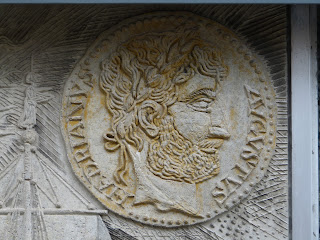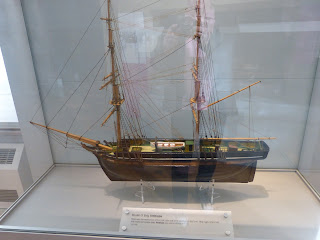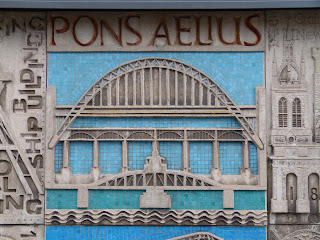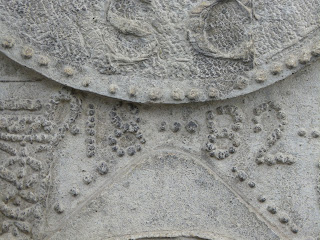The mural is on the side wall of what is now Primark, but was originally British Home Stores. Whilst the main store front is on Northumberland Street, the Collins' work can be found on the adjoining Northumberland Road. I have visited Newcastle on several occasions, and I must have walked within 50 metres of the mural numerous times without spotting it.
The mural was installed in 1974, and is in two main sections. It is in keeping with many of the other concrete murals by Henry and Joyce Collins by depicting the history of the locality.
It starts with "Monkchester", which was the name of the Saxon settlement where Newcastle now stands. Below the name is the depiction of a River God, and the Newcastle coat of arms.
The River God is a big thing in Newcastle (perhaps not surprising for a settlement which has been dependent on the River Tyne for its livelihood), and another example can be found on the Civic Centre - this is the River God Tyne fountain (in brass rather than concrete) by David Wynne, which predates the Collins' work by six years.
To the right of the coat of arms is a ship, and a Hadrianus Augustus coin. Hadrian was Roman Emperor from 117 to 138 AD.
On the bottom part of the mural is a collier brig, a type of ship used for transporting the locally-produced coal. I am not aware of what the dates 1704 to 1880 refer to.
A model of a collier brig can be found in the Discovery museum.
Completing this section of the mural is the name Oceanus, a water-related god, various nautical symbols, and a seahorse with a trident.
The right-hand section is over twice the length of the left-hand one, and continues the historical theme.
Below the two figures are some geometric patterns - are these perhaps Roman mosaics found in the area?
We are on to a bit more solid ground of knowledge on the next section of the mural. Here we see reference to industry and science, with engineering, ship building and coal mining spelt out.
In the top left we see images of two miners' safety lamps, and the names Davy and Stephenson. Humphry Davy invented the safety lamp in 1815, and a similar design was invented at the same time by George Stephenson.
To the right of the safety lamps we have the word glass cone and NGC 1887. Glass cones were used in the manufacture of glass, another local industry. The initials NGC could stand for the Northumberland Glass Company, but the 1887 date suggests that it might actually refer to Northwood Glass Company of Ohio, founded in that year by Henry Northwood who emigrated to America in 1880.
Completing this section we have an image of a black wagon - which were used to transport the coal from the collieries to the coast for export to London and elsewhere.
The bottom half of this section continues the industry / science theme.
Armstrong Whitworth was an engineering company based in Newcastle. Founded in 1847, production at the Scotswood works continued until 1979. The company made aircraft, armaments, locomotives and ships, and the two products shown here - the Armstrong Whitworth B3 car of 1911, and the 12 Pounder, an artillery piece from the 1850s.
G & R Stephenson are father and son George and Robert Stephenson. George Stephenson (1781 - 1848) was a civil and mechanical engineer, and a railway pioneer. His use of the 4 feet 8.5 inches gauge became the standard for many railways around the world. His statue can be found near to the railway station. Robert Stephenson was the designer of Rocket, which in 1829 was the winner of the Rainhill Trials to find a locomotive design for the Liverpool and Manchester Railway.
J Swan refers to Sir Joseph Wilson Swan (1828 - 1914), who was an early developer of the incandescent light bulb. Mosley Street in Newcastle was the first street in the country to be lit by electric light.
The three bridges shown are the Tyne, Swing and High Level.
The Tyne Bridge was built 1925 - 28. With a span of 161 meters, it is a reduced version of the Sydney Harbour bridge. It was designed by Mott, Hay and Anderson, with R. Burns Dick as architect.
The Swing Bridge is by W.G. Armstrong & Co, and was built in 1868 - 76. When opened it was the largest swing bridge in the world.
And finally the High Level Bridge, which is a combined road and rail bridge designed by Robert Stephenson and T.E. Harrison, and built in 1845 - 49.
And here is my rough approximation of the way the bridges are shown on the Collins' mural:
The bottom half of this section covers shipbuilding, with a shipyard crane and the vessels Turbinia and Mauretania.
Turbinia can now be found in Newcastle's Discovery museum. It was built in 1894 at Brown and Hood in Wallsend to demonstrate the capabilities of the Parsons steam turbines. As well as being the first steam turbine powered boat, it was also the fastest ship in the world capable of 34.5 knots.
The Discovery museum also currently has a Lego model of Turbinia on display.
Mauretania would have been a bit too big to fit in the museum. Launched in 1906 and built by Wigham Richardson and Swan Hunter, at 32,000 tonnes it was the largest ship in the world. Sharing Turbinia's lust for speed, the Mauretania was the holder of the Blue Riband for 20 years. The ship was retired from service in 1934 and subsequently scrapped, but on of the 'E' s from the ship's name can be found in the Discovery Museum.
The next (very busy) section covers architecture.
The montage of buildings shows, if my detective work is correct, the following buildings:
(1) The Cathedral Church of St Nicholas - which dates from the 12th century, although most of the building is 13th and 14th century, hence the reference to the 14th century on the mural;
(2) The Castle Keep, dating from the 12th century:
(3) All Saints - by David Stephenson (1757 - 1817) and built 1786 - 96:
(4) St Thomas the Martyr (1830), designed by John Dobson (1787 - 1865):
The names included on the mural are the architects listed above, plus the following:
- Richard Grainger (1797 - 1861) - Born in High Friar's Lane, he was an influencial builder and developer, after whom the Grainger town area of Newcastle is named.
- William Newton (1730 - 1798) - an architect whose works include the Assembly Rooms.
- John Stokoe (1756 - 1836) - builder and architect, with son William Stokoe. works include the Moot Hall.
The bottom half is more mixed. It continues the architectural theme with the Theatre Royal (1836-37) by John and Benjamin Green.
But it also includes a coin, a statue of Brigantia, and a Bewick Swan.
The coin is Roman, with SC indicating the conquest of Scotland.
There is a date of 1882, which I assume refers to when the coin, or possibly the statue of Brigantia, was found.
The Brigantes were the Celtic people of the region known as Brigantia.
The Swan is a reference to Thomas Bewick (1753 - 1828). Born in Northumberland, Bewick was a wood engraver and natural history author, whose most famous publication was A History of British Birds (1797). The Bewick swan is named after him. A statue of Thomas Bewick can be found on the side of a building in Northumberland Street.
The final section of the mural starts with two figures of Geordies.
Below them is reference to The Keel Row, a traditional Tyneside folk song.
The words to the song include the lines:
As I came thro' Sandgate,
Thro' Sandgate, thro' Sandgate,
As I came thro' Sandgate,
I heard a lassie sing:
'O, weel may the keel row,
The keel row, the keel row,
O weel may the keel row
That my laddie's in.'
'He wears a blue bonnet,
Blue bonnet, blue bonnet,
He wears a blue bonnet
A dimple in his chin.
And weel may the keel row,
The keel row, the keel row,
And weel may the keel row
That my laddie's in.'
Thro' Sandgate, thro' Sandgate,
As I came thro' Sandgate,
I heard a lassie sing:
'O, weel may the keel row,
The keel row, the keel row,
O weel may the keel row
That my laddie's in.'
'He wears a blue bonnet,
Blue bonnet, blue bonnet,
He wears a blue bonnet
A dimple in his chin.
And weel may the keel row,
The keel row, the keel row,
And weel may the keel row
That my laddie's in.'
And finally, the signature of Henry and Joyce Collins, dated 1974, can be found at the feet of the Geordies.
Photographs taken on 16th / 17th September 2019.



















































